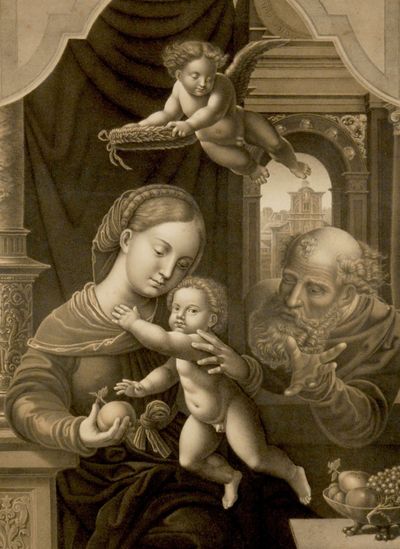Artwork at Gonzaga unveils biblical narrative

At the Jundt Art Museum on Gonzaga University’s campus, 16 pieces of art on display are united by this theme: The Holy Family.
Crèches, lithographs, wood engravings and etchings depict artistic interpretations of Mary, Joseph, Jesus and some of the others they encountered as described in the biblical narrative of Jesus’ birth.
The art spans several centuries, from the 1600s to the 1980s.
Patrick McCormick, professor of religious studies at GU, has written several books on theology and is a monthly columnist for U.S. Catholic magazine. He agreed to walk through the exhibit with a theologian’s eye.
Pondering the Holy Family, in art or in narrative form, provides insights into modern families, no matter a person’s faith tradition. Here, McCormick shares some of his insights.
•Parenting is always a leap of faith
“In the narrative, both of the parents have to make an amazing act of faith,” McCormick says. “Mary has to take this extraordinary risk in accepting the child. Joseph has to take this extraordinary risk in accepting Mary and the child.”
Mary is betrothed to Joseph, but not yet married – and she’s pregnant.
“The assumption would be that she had committed adultery,” McCormick points out. “It would have been within his legal rights to put her away. The fact he decides to embrace her and embrace the child is a courageous and generous act on his part.”
Parenting was a risk in ancient times and remains so today.
“Any person who decides to become a parent moves from a life they know into a life for which they are completely unprepared,” McCormick says.
“The risk is that they will not be prepared, not be able to do this well. And there’s no knowing what the child will be like. The child could be sickly or this could all end so badly.
“What’s nice about the narrative is that it makes it clear that both people need to take this risk. It’s not just her.”
•Many families live on society’s margins
Mary and Joseph are away from home when Jesus is born. They have traveled to Bethlehem to be counted in a Roman census.
Things are crowded everywhere. There is no room in any inn. The child is born in a manger.
“It’s very humiliating that the only place you’d have to give birth to your child is a stable where animals would be,” McCormick says. “This family is from very common stock. They are ordinary people.”
It would be interesting, he says, to place these Holy Family art pieces next to photographs taken during the Great Depression by Dorothea Lange, especially her iconic migrant mother photos. The migrant mother has aged prematurely from relentless poverty.
“Some of those pictures lined up with these would give you a sense of what the Biblical authors were really trying to capture,” McCormick says.
This is also a family that lives at the edge of violence.
When Herod hears that the child has been born, he orders the massacre of all the boys in Bethlehem and its vicinity who are 2 years of age and younger.
“So many families in the world live next to violence,” McCormick says. “The Holy Family is not separate from that. They are immersed in that world. Both the birth in the stable and the slaughter are a way of humanizing and connecting them with the outcasts.”
•Families need larger communities
The notion of the nuclear family doesn’t really fit with this Biblical family.
Families in the time of Jesus “lived in compounds that had a number of families living together and sharing a cooking area,” McCormick points out. “Nobody lived in a McMansion. They depended on other families to share the work and the cooking and the child-rearing.
“Later, when they take the 12-year-old (Jesus) down to Jerusalem, they are going with a caravan. So the women are traveling together and the men are traveling together,” he says.
“The boy is expected to be with one of them. If he’s very small, he should be with the women. If he’s older, he’ll be with the men. There’s much more of a sense of connectedness to a larger community.”
•Photos tell a lot about family dynamics
The Holy Family lithograph from the exhibit, pictured with this story, is the work of German artist Johann Nepomuk Strixner and not an actual photograph, of course.
But looking more closely at the faces in the lithograph reveals some Holy Family dynamics, just as modern photographs can sometimes hint at deeper issues within families – and within societies.
In the lithograph, notice that Joseph is depicted as an old man.
“In most paintings, he’s not a young man,” McCormick says. “Mary was probably in her mid-teens, and it’s unlikely Joseph was any older than his early 20s.
“We’re comfortable with him being a protector but less comfortable with him being Mary’s husband and beloved. I think that’s why Joseph is kept somewhat at a distance in the (art), and he’s rendered old.”
And notice the eyes in the lithograph. The parents look at the child, but child looks outward toward the viewer.
“The family is never an object just to be admired, looked at from a distance,” McCormick says. “The Christ child is always an invitation to the viewer to embrace your humanity by stepping into relationships with other people.
“Who is it that’s inviting you? A baby. The baby needs nurturing and food and shelter. He’s inviting you to come into the family by accepting responsibility to care for others.”